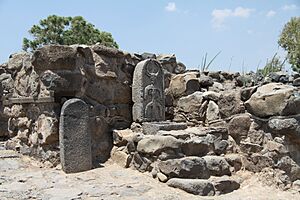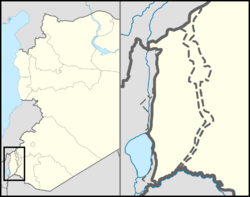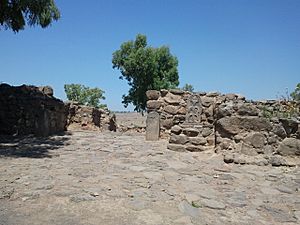Bethsaida facts for kids
|
בית צידה (Hebrew)
|
|
| Lua error in Module:Wikidata at line 70: attempt to index field 'wikibase' (a nil value). | |
| Alternative name | بيت صيدا (Arabic) |
|---|---|
| Location | Golan Heights |
| Coordinates | 32°54′36″N 35°37′50″E / 32.91000°N 35.63056°E |
| History | |
| Founded | 1st century BC |
| Abandoned | 65 AD |
Bethsaida is an ancient place mentioned in the New Testament of the Bible. Its name comes from Aramaic and Hebrew, meaning 'House of the Fisherman' or 'House of the Hunter'. It was also known as Julias. Bethsaida is located in the Golan Heights, near the Sea of Galilee.
Contents
History of Bethsaida
Bethsaida in the New Testament
The Bible tells us that Bethsaida was the hometown of three of Jesus's apostles: Peter, Andrew, and Philip.
Important events from the Bible happened near Bethsaida:
- Jesus healed a blind man just outside the village.
- Jesus miraculously fed five thousand people with only a few loaves of bread and fish.
Ancient writers like Pliny the Elder and Josephus described Bethsaida as being on the eastern side of the Sea of Galilee, not far from where the Jordan River flows into the lake.
Today, experts are still trying to find the exact spot of ancient Bethsaida. Three main places are considered:
- Messadiye (a Bedouin village)
- El-Araj (a small, deserted settlement)
- Et-Tell (an archaeological mound)
El-Araj and Et-Tell are thought to be the most likely locations.
Archaeological Discoveries
Archaeologists are like history detectives. They dig up old sites to learn about how people lived long ago. There are two main archaeological sites that might be Bethsaida:
- Et-Tell, located on the east bank of the Jordan River.
- El-Araj, located closer to the Sea of Galilee.
Et-Tell: A City on a Hill
Many archaeologists believe that Et-Tell was once the capital city of an ancient kingdom called Geshur. People also lived here during the time of Jesus.
The first excavations at Et-Tell happened in the late 1980s. More recently, Professor Rami Arav has led digs there. He believes Et-Tell is Bethsaida. One challenge is that Et-Tell is about 2 kilometers (1.2 miles) from the Sea of Galilee. This is a bit far for a fishing village!
Scientists have some ideas to explain this:
- The land might have been lifted up by earth movements.
- The water level of the Sea of Galilee might have dropped over time due to people using more water.
- The Jordan River might have built up more land (a delta) over thousands of years, pushing the shoreline further away.
Life in the Bronze and Iron Ages

Digs show that people first settled at Et-Tell around 1000 BCE (Before Common Era). This was during the Bronze Age and Iron Age. It was a strong, fortified town, possibly linked to the biblical kingdom of Geshur.
Archaeologists have found impressive city gates from the 8th century BCE. They are still looking for even older gates from the 10th century BCE. Et-Tell was likely the biggest and strongest city east of the Jordan Valley during the Iron Age II period. In 2018, archaeologists found another city gate, which they think might be from a city called Zer, mentioned in the Bible.
Hellenistic and Roman Times
During the first centuries BCE and CE (Common Era), Et-Tell was still inhabited, but it was smaller than before. Archaeologists have found many things related to fishing, like lead weights for nets and needles for repairing them. This shows that fishing was very important to the city's economy.
They also found ancient coins from different periods. One important discovery was a coin from Philip the Tetrarch, a son of Herod the Great. Around 4 BCE to 34 CE, Philip renamed Bethsaida to "Julias" in honor of Julia, the daughter of the Roman Emperor Caesar Augustus.
El-Araj: The New Favorite?
El-Araj is another strong candidate for the location of Bethsaida. According to the historian Josephus, around 30-33 CE, Philip the Tetrarch made the village of Bethsaida a "polis" (a major city) and renamed it Julias. It was located near where the Jordan River flows into the Sea of Galilee.
The Bible describes Jesus going to a "desert place" near Bethsaida to rest. This "desert" likely meant an uncultivated area used for grazing animals, not a sandy desert. The "green grass" mentioned in the Bible fits the rich soil of the plain near El-Araj.
In 2017, archaeologists at El-Araj found a Roman bathhouse. Finding a bathhouse is important because only a major city (a polis) would have had one. This suggests El-Araj was indeed a significant Roman city. They also found signs of a Byzantine church, which matches descriptions from an ancient traveler. These discoveries make El-Araj a very strong candidate for Bethsaida.
In 2019, the El-Araj team found what they believe might be the "Church of the Apostles." This church from the Byzantine period is thought to have been built over the home of Peter and Andrew. They found beautiful mosaic floors, gilded glass, and marble decorations. In 2022, they uncovered a large mosaic with an inscription that mentions St. Peter as "the chief and commander of the heavenly apostles." This further strengthens the idea that El-Araj is the true site of first-century Bethsaida.
El-Mesydiah: A Less Likely Spot
El-Mesydiah is a third possible location, but most experts don't think it's the right one. It's on the current shoreline, but early digs didn't find many ruins from before the Byzantine period. Also, its name is very different from Bethsaida.
One or Two Bethsaidas?
For a long time, scholars have debated whether there was only one Bethsaida or two different places with that name. Some believe all the Bible stories refer to the same place, Bethsaida Julias. Others think there might have been a second Bethsaida, perhaps on the western side of the Jordan River. This is a complex discussion, but the recent archaeological finds at El-Araj are helping to shed more light on the mystery.
1217 Battle
During the Fifth Crusade, a large army led by King Andrew II of Hungary fought against Sultan Al-Adil I at Bethsaida on November 10, 1217. The crusader army won, and the Muslim forces retreated.
See also
 In Spanish: Betsaida para niños
In Spanish: Betsaida para niños




